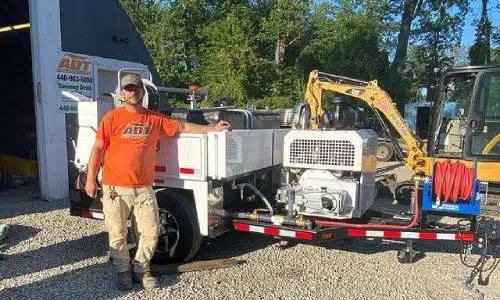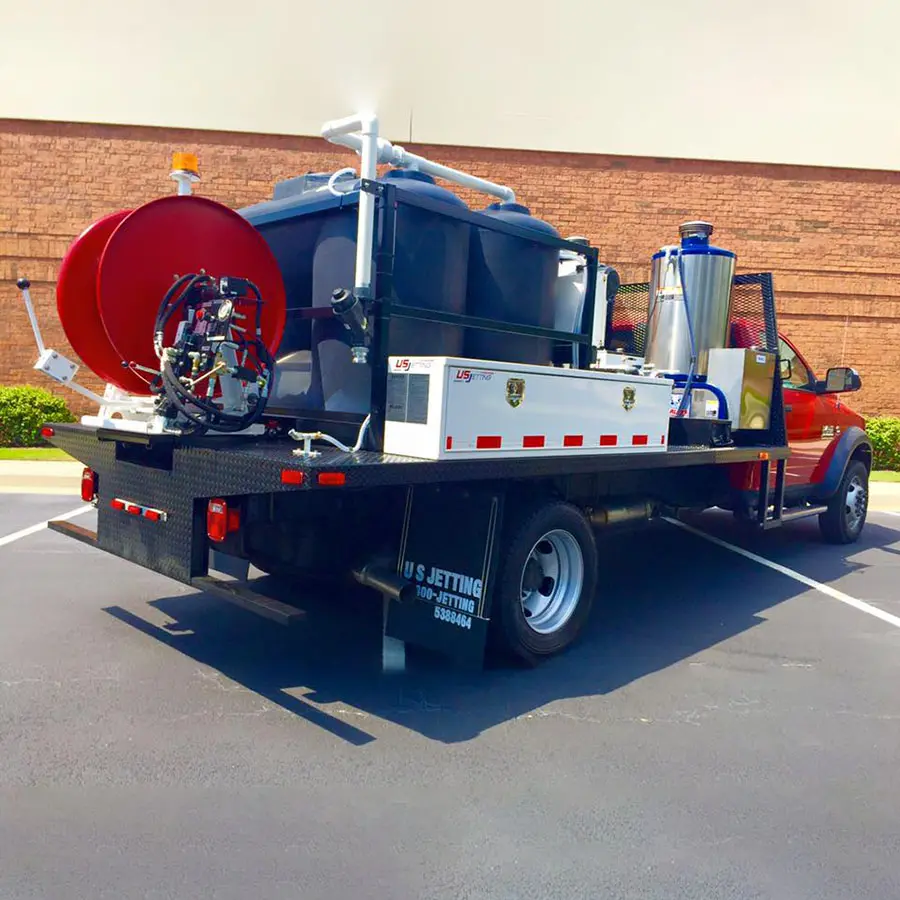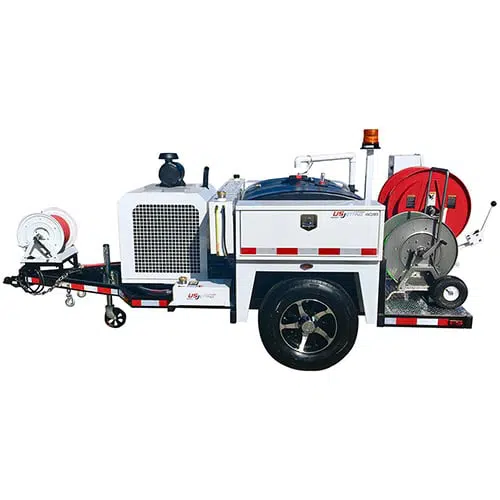1. Introduction to Hydro Jetting
Although hydro jetting has existed for decades, advancements in technology have made it possible for more plumbing professionals to offer this service to clean sewer lines and efficiently remove obstructions. A particular area of advancement would be in the cameras that can be used to inspect every detail of a pipe issue.
If you’re ready to learn more about this progressive plumbing technique, this comprehensive guide will provide you with everything you need to know about hydro jets, the jetting process, and the equipment required to perform this work.
How Does a Hydro Jet Work?
A hydro jet is a machine engineered to clean drains, pipes, or surfaces. By utilizing high pressure water, the jetter can blast through blockages and wash debris back down the line. Most US Jetting units have a run-dry pump which is what creates the high pressure water directed through the sewer hose and into the nozzle. When the water exits the nozzle it reverts from pressure inside the hose to velocity or speed. It is the speed of the water combined with the volume that does the work. In some cases the speed can exceed 400 miles per hour. The quantity, quality and location of the nozzle jet inserts and rotational ability is what determines the best application for each nozzle.
For plumbing maintenance, hydro jetting offers many benefits, including:
- Removing hard build-ups that could damage pipes
- Preventing sewer back-ups in businesses and residences
- Cleaning pipes to improve long-term performance and prevent future blockages
- Effectively clearing lines of grease, roots, ice, mud, sand, and minerals
Where is Hydro Jetting Used?
Hydro jetting is beneficial for a variety of applications, including but not limited to:
- Restaurants and food processing plants: Even with drains that catch large food particles, fat, oil, and grease (FOG) still make their way into pipes at these locations. Over time, these materials coat the walls of pipes and accumulate, resulting in hard blockages that clog the lines.
- Municipal and commercial sewer systems: The size of municipal and commercial sewer pipes makes these areas ideal candidates for hydro jetting. Snaking or chemical cleaners aren’t powerful enough to clear these vast pipe systems effectively.
- Residential sewer systems: Residences suffering from frequently clogged lines or sewer back-ups benefit from hydro jet drain cleaning. Jetting operators use specialized nozzles and smaller hoses to tackle jobs in residences. Besides effectively clearing lines, hydro jetting flushes debris to the larger municipal sewer, removing the clog completely.
2. The Hydro Jetting Process: A Step-by-Step Explanation
How do hydro jet operators use these machines to clear away dirt and debris from sewer lines? Here is a step-by-step outline of the process and the tools they use:
- When a plumbing professional arrives on the scene, they must first determine an access point to the pipes which will ideally be a outside cleanout.
- From that access point, the operator will determine if the blockage is built up enough that they need to clear the blockage prior to inspection.
- If the pipe isn’t completed clogged, the operator can inspect the pipe using a RIGID SeeSnake or a similar camera. Videoing the line informs the operator where the problem is and what is causing the blockage, allowing them to design a strategy to clean the line.
- Once the obstruction is identified, the operator can select the correct tools for the job. They will need the correct hose and nozzle for the pipe’s size to tackle the specific clog. Numerous hydro jet nozzles are available on the market; some are general-purpose nozzles for routine cleaning, while others are designed specifically to cut through certain materials like grease or tree roots.
- The operator will place the sewer hose into the pipe. Once it’s safely a few feet inside the pipe, the operator will either turn on the jetting machine or manually push the hose into the pipe until it reaches where the camera is located marking the blockage point.
- The operator will pull back the camera to avoid any high pressure water damage, and jet the line.
- Once the operator believes the pipe is fully cleared, he will inspect again with the camera to ensure no debris is left behind.
3. When is Hydro Jetting Necessary?
Sewer jetting is a versatile practice used to solve many plumbing issues where traditional methods fail.
Here are some situations where hydro jetting is necessary:
- Cleaning storm drains and culverts: Storm drains and culverts are often clogged with thick mud and sand sticks and bottles. The only way to clean these large pipes is with hydro jetting. An operator will use a specific sand and sludge nozzle in these situations. These nozzles are weighted, allowing them to stay at the bottom of the line as they clear away heavy materials. The 2065 Max Flushing hydro jet is ideal for completing these jobs because of its increased flushing capacity.
- Frequent clogs or slow drains in residences: If homeowners are struggling with recurring clogs and slow draining, hydro jetting offers a much longer lasting solution. If a snake is used instead of a hydro jetter, it will likely only penetrate a small hole through the blockage and not properly blast out the debris causing the blocked pipe to remain partially blocked.
- Residential lines are susceptible to blockages from grease, tree roots, wipes and other debris that is often flushed down the toilet, which can only be tackled properly with a hydro jetter.
- Routine maintenance for municipal, residential, industrial or commercial lines: Routine cleaning and maintenance of pipe lines keeps pipes clear and prevents businesses, homeowners, and factories from costly down time.
Hydro Jetting vs. Traditional Snaking Methods
Before hydro jetting, plumbing experts relied on snaking or chemical cleaners to clear blockages from pipes. These methods were time-consuming, and they couldn’t be applied to more extensive sewer lines in commercial or municipal settings. Hydro jetting is considered to be the far superior modern innovation in sewer cleaning technology.
Take a closer look at the advantages hydro jetting has over traditional snaking methods below:
- Long-term solution: Traditional plumbing methods could create a hole in the clog for water to drain through, but they didn’t provide pipes with a 360-degree cleaning to prevent residue from building up again. Hydro jet nozzles blast through clogs while fully cleaning the pipe’s walls to provide a long-lasting solution.
- No harsh chemicals: Hydro jetting uses a highly concentrated water stream to break up debris effectively and flush it away. No dangerous chemicals are needed, reassuring many businesses and homeowners.
- Ideal for commercial and municipal lines: These pipes have a large diameter, and attempting to snake these lines would barely put a dent in the clog. Hydro jetting technology and equipment have evolved to effectively clean and tackle obstructions in these substantial pipes.
- Efficient and effective: Overall, sewer jetting is a time-saving method that allows municipalities and businesses to restore their sewer lines quickly. Plumbing is an essential feature of communities, and these systems must be operational for health and safety reasons.
5. Cost Analysis of Hydro Jetting
As with any professional service, hydro jetting’s cost varies greatly depending on the work performed, the time it takes to complete a job, and the equipment needed.
When assessing the cost of hydro jetting and plumbing services, it is important to keep these factors and potential savings in mind:
- Preventative solution: Hydro jetting is essential to a preventative plumbing maintenance plan. By thoroughly cleaning lines, sewer jetting extends the life of pipes and eliminates the need for expensive, premature repairs or replacements.
- Long-lasting results: Today’s jetting innovations blast away tough clogs and target all areas of the pipe to deliver lasting results. From tree roots to grease to mineral deposits, all these materials and more can be effectively removed to prevent more invasive and expensive repairs.
- Fast removal of blockages: In a plumbing emergency, every second counts in eliminating the possibility of further damage. An efficient hydro jetting service is more affordable than replacing a residential line or similar pipe.
6. Safety Considerations and Precautions
Commercial hydro jets should only be operated by trained plumbing professionals who understand all the safety procedures. This will prevent on-site injuries and keep everyone safe when completing a job.
Operator Safety
Besides proper training and certification, hydro jet operators need personal protective equipment (PPE) when working. This equipment can include:
- Safety gloves, safety vests, jackets, and coveralls rated for high pressure water resistance
- Work boots
- Helmet
- Visor or goggles
- Ear protection
Equipment Protection
Safety tools for hydro jetting equipment – including the hose and nozzle – are essential to keep these components functioning optimally.
Explore the equipment designed to be used with hydro jetting tools below:
- Manhole protector
- Manhole roller
- Tiger tail
- Safety leader hose
7. Conclusion
Hydro jetting revolutionized sewer cleaning and maintenance, allowing contractors to tackle tough jobs quickly and successfully. This method has diverse applications across many locations, including municipal lines, commercial facilities, and residential areas.
To learn more about this innovative practice, contact US Jetting. With over 50 years of experience in the industry, we are the leading manufacturer and provider of quality hydro jets and accessories. We equip plumbing experts with the tools to handle tough jobs and keep sewer lines running properly.
Call US Jetting today to speak to a knowledgeable representative to learn more about our products and services.




